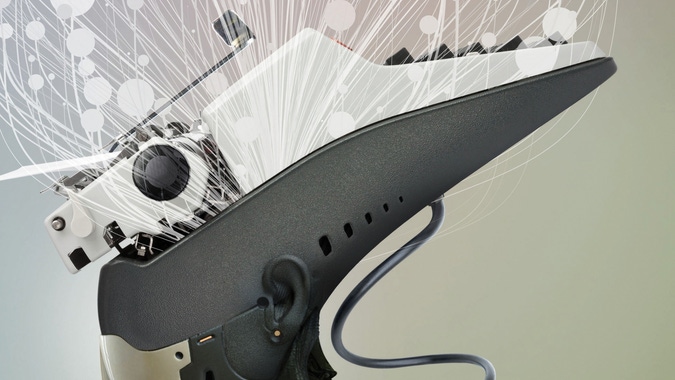Could This Robot ( GPT-3) Be Your Marketing Writer?

Could This Robot ( GPT-3) Be Your Marketing Writer?
In July 2020, an innocuous article was published on the otherwise unclear blog “Nothing But Words” that made headlines from MIT Technology Review to NBC. Why? Because although dozens of people are arguing about its content, it turns out that most of the words are not actually written by people. They were written by a new artificial intelligence model GPT-3 and published by Liam Porr. Liam Porr is a student at the University of California, Berkeley. In his opinion, GPT-3 is about to change the way we write, and this blog post became compelling proof.

Many people agree with this, which leads to some interesting business problems. When the writing ability of software is almost as good as human beings, how will this change the written way of marketing copy, the way brands communicate, and even the way they interact with customers?
Some entrepreneurs, such as Dave Rogenmoser, founder of Jarvis, a marketing company, are already exploring this answer. GPT supports his software and can write almost anything for his customers. From email to website content to long books. “GPT-3 allows you to attain 80% of your goal,” he said.
This is not new. The first language model was established in the late 1950s. Since then, similar models have been used for spell checking and word-based video subtitles. What makes GTP-3 different? It’s really big. It is trained on the common crawl, a real-world human-generated web text dataset. Relying on volunteer-driven Internet archives, the public crawl is a 1.2 billion word corpus, collected from blogs, forums, and encyclopedias. It is one of the largest public network data resources released to the public in history.
Table of Contents
What is GPT-3
So what is GPT-3? This is the third iteration of the artificial intelligence language model, called the generative pre-training converter (GPT). GPT is a creation of OpenAI, an artificial intelligence research laboratory whose founders include Elon Musk. GPT-3 was released in June 2020 after being trained on hundreds of billions of words and a large number of books from the Internet.
It works by being prompted. Users can enter a few words in GPT-3 – for example, the beginning of a blog post or a product sales promotion, and then define some parameters, such as how long GPT-3 should last. With these, the software can directly write the rest of the content and use deep learning to generate human-like text.
Mira Murati, senior vice president of research, products, and partnership at OpenAI explained: “it is good at understanding the structure of what should happen next after you provide input.”. GPT-3 is also good at answering trivial questions, summarizing text, performing complex searches. Even, to Murati’s surprise, it is also good at coding. “We didn’t expect,” she said, “but you can imagine that there may be JavaScript on the Internet. It must be enough to give it some capability .”
The model is still in private testing. But over the past year, OpenAI is carefully providing access to enterprises and researchers so that they can observe, what Murati calls “How it can use in the wild” while formulating standards and security protocols. Of the 300 applications using GPT-3 at press time, entrepreneurs have invested in promoting marketing content, using data to drive product development, and creating dialogue for game characters. Of course, some people have used it to start new businesses.
Human chat robot
Typeform is an early adopter. It doesn’t let GPT-3 write anything, but it does use artificial intelligence in its latest product VideoAsk to understand what people who interact with the tool need. VideoAsk has created a customizable “human chat robot”. Which has the function of a text-based chat robot (asking questions and obtaining answers), but the information is transmitted through the video snippets from a person who filmed own self giving several different answers or responses. GPT-3 is using to understand what customers say to the robot and send them to the most related and appropriate next step. Founder David Okuniev said: “This is a very good match for what we do”.
Of course, GPT-3 is not omnipotent, and early users will soon find its advantages and disadvantages. Quizlet is an educational technology innovator with 250 employees and 60 million student users. He is excited to explore GPT-3. It has used a lot of machine learning to personalize learning tools, such as digital flashcards. And found that GPT-3 performs well in how to use words in sentences for teaching vocabulary. “We provided it with five to ten examples. It is really good at learning from them and creating new and interesting examples,” said Ling Cheng, director of data science at Quizlet.
However, as is common in all machine learning tools, it is not always good at being sensitive to Quizlet’s young audience. “We found few sentences in GPT-3 a little biased or offensive, so we used its content filter [to classify text as safe, sensitive or unsafe] and were surprised to find it quite good,” Cheng said. “There are many studies on reducing the bias in these models, but this is what we have been thinking about.”
Common problems.
OpenAI is studying this, as well as another common problem with machine learning models. Sometimes they just spit out something gobbledygook. “Like, they might make up something,” Murati said. “You provide an input that they can produce something that doesn’t fit in with reality at all.”
She said that OpenAI would continue to select applicants to use GPT-3; The price depends on usage. (meanwhile, they have licensed their products and services to Microsoft.) then wait? OpenAL has a new AI model called DALLE-E, which converts text input into images.
Meanwhile, Jarvis’s Rogenmoser says he only needs to set expectations: the writing of GPT-3 is not perfect, but it’s close enough to save a lot of time. Rogenmoser started Jarvis (originally called conversion AI) to automatically write Facebook ads for his customers, but later he saw them use it for almost any other form of marketing writing. He suggested that they use the copy of GPT-3 as a starting point – “then you mix and match what you like, put it together, and add your own things, so you still need to know what looks good. But you don’t have to stare at this blank screen and start from scratch.”
Many people seem to be happy without a blank screen. In Jarvis’s first six months, it attracted 20000 customers, most marketers, and small businesses, and raised $6 million. When competitors began to emerge, Rogenmoser bought two of them.
GPT-3 will change the lives
He is now convinced that GPT-3 will change the lives of entrepreneurs and completely change the way code-less movement works. “We see that many small businesses are using it to build websites they have never established, send email to customers more frequently and start posting on social media,” he said. “Maybe they don’t have the money to hire marketers, but with this, they can be very close. This reduces the start-up cost of really going out and competing at the beginning. To be honest, GPT-3 will mean a paradigm shift.”
GPT-3 did not write the last line — or any line.
We do promise.
We would love to hear about your ideas, suggestions, and questions. So feel free to contact us.
Lucas Noah, a distinguished writer with a Bachelor of Information Technology (BIT) degree, is currently making waves in the digital content sphere with his contributions to Creative Outrank LLC and Oceana Express LLC. His work on their websites showcases hi... Read more